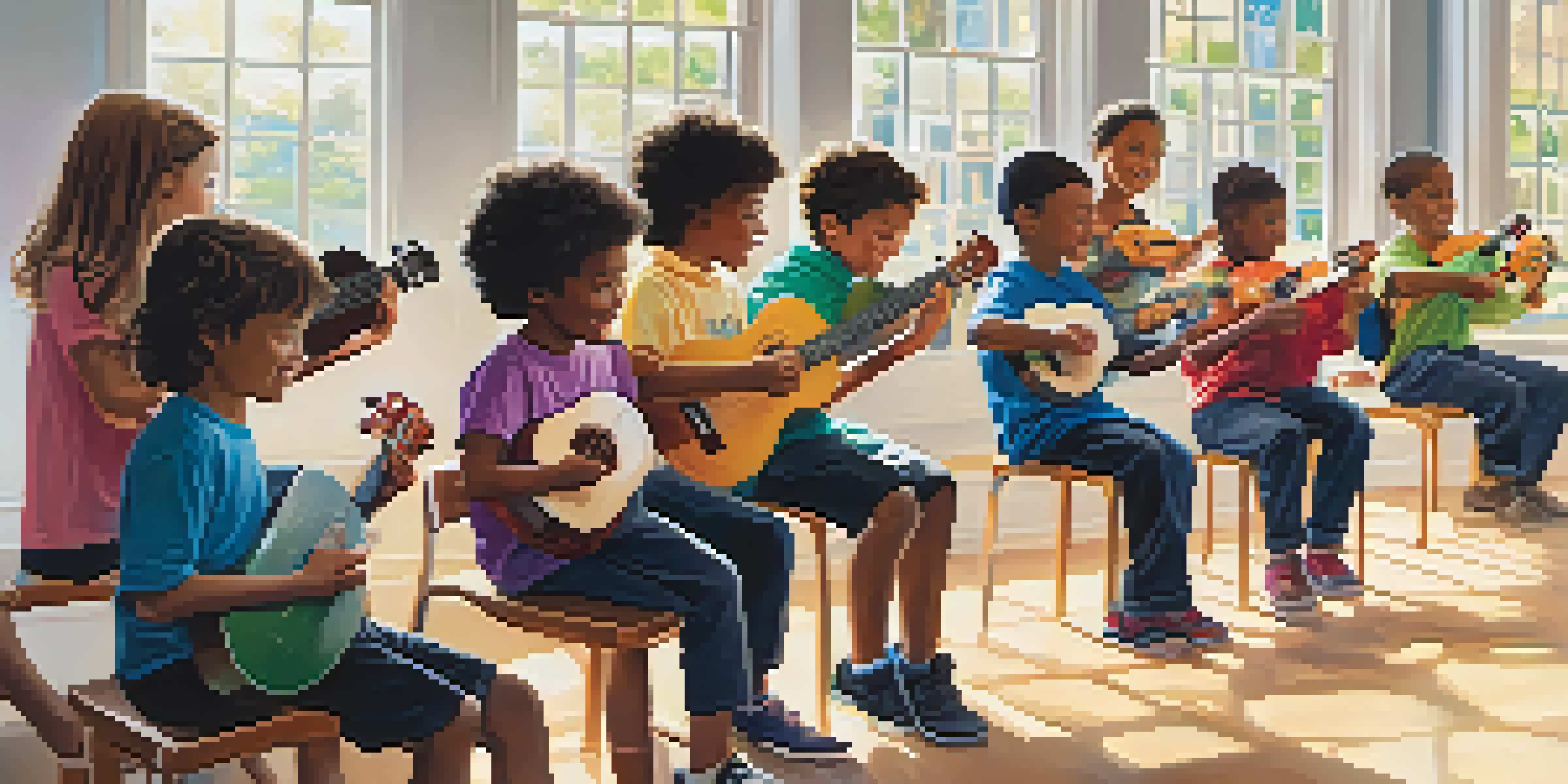Teaching Rhythm and Timing Concepts with the Ukulele

Understanding the Basics of Rhythm and Timing
Rhythm is the heartbeat of music, providing structure and flow. It encompasses the timing of notes and the patterns they create, which is essential for any musician, especially ukulele players. Timing, on the other hand, refers to how these notes are spaced out in relation to a beat, forming the backbone of a musical piece.
Rhythm is the pulse of music, providing the foundation upon which melodies and harmonies can build.
When teaching rhythm, it's helpful to break it down into simple, manageable parts. For instance, clapping along to a metronome can instill a sense of steady beat, which is foundational for any musical endeavor. By grasping rhythm and timing early on, students can develop a strong musical foundation that will serve them well in their ukulele journey.
Using visual aids like rhythm charts can further enhance understanding. These charts display various note values and rests, allowing students to see how they fit together. By relating these concepts to the ukulele, such as strumming patterns, learners can more easily internalize the relationship between rhythm and timing.
Engaging Students with Fun Ukulele Exercises
One of the most effective ways to teach rhythm is through engaging exercises that incorporate the ukulele. Simple strumming patterns, such as down and up strokes, can be practiced while counting aloud to reinforce timing. This not only keeps learners focused but also helps them connect physical movement with auditory cues.

Incorporating clapping games or body percussion can also enhance the learning experience. For example, have students clap a rhythm before attempting it on their ukulele. This method allows them to feel the rhythm in their bodies, thereby making the transition to playing the instrument smoother and more intuitive.
Rhythm is Key for Musicians
Understanding rhythm and timing is essential for musicians, particularly ukulele players, as it provides the structure and flow necessary for playing music.
Additionally, using popular songs that students enjoy can motivate them to practice. By playing familiar tunes, learners can see how rhythm and timing play a crucial role in music they love. This connection fosters a deeper appreciation for the ukulele and encourages consistent practice.
Utilizing Metronomes and Rhythm Apps
In the digital age, metronomes and rhythm apps have become invaluable tools for teaching timing concepts. These devices provide a steady beat, allowing students to practice playing in time. By gradually increasing the tempo, learners can challenge themselves and track their progress over time.
Music is the shorthand of emotion.
Rhythm apps often come with engaging interfaces that gamify the learning process. Students can play along with different rhythm patterns, making practice feel less like a chore and more like a game. This interactive element can significantly boost motivation and retention of timing concepts.
Encouraging students to set their own goals with these tools can also enhance their learning experience. Whether it's mastering a new strumming pattern or playing a song at a faster tempo, having clear objectives keeps learners focused and accountable.
Exploring Different Time Signatures on the Ukulele
Time signatures are essential in music, dictating how many beats are in a measure and which note gets the beat. The most common time signature is 4/4, but exploring others like 3/4 or 6/8 can open up a world of rhythmic possibilities on the ukulele. Understanding these signatures allows students to play a wider variety of songs and styles.
When introducing new time signatures, it's helpful to use visual aids and simple examples. For instance, tapping out the beats for a waltz (3/4) can illustrate how it differs from a standard 4/4 rhythm. This tangible approach makes abstract concepts more relatable and easier to grasp.
Engaging Exercises Enhance Learning
Incorporating fun exercises, like strumming patterns and clapping games, helps students connect rhythm with their ukulele practice, making learning more intuitive.
Encouraging students to experiment with different strumming patterns for each time signature can also be a fun exercise. This not only reinforces their understanding but also builds their confidence in applying what they've learned in a creative way.
The Importance of Consistent Practice
Consistent practice is the key to mastering rhythm and timing on the ukulele. Setting aside dedicated time each day helps reinforce the concepts learned in lessons. Even short, focused practice sessions can lead to significant improvements over time, making it easier for students to internalize rhythms.
Encouraging students to establish a routine can also foster a sense of discipline. Whether it’s practicing with a metronome or working on their favorite songs, having a structured approach can make practice more enjoyable and productive. This consistency not only helps with rhythm but also enhances overall musicality.
Moreover, celebrating small milestones can keep motivation high. Recognizing progress, whether it's mastering a challenging strumming pattern or playing a song in time, can boost confidence and encourage students to keep pushing forward.
Incorporating Group Activities for Collaborative Learning
Group activities are a fantastic way to teach rhythm and timing concepts, as they foster collaboration and community among learners. Organizing jam sessions, where students play together, can help them develop their timing while listening to others. This real-time feedback is invaluable, as it sharpens their ability to stay in sync with fellow musicians.
Additionally, group exercises can include call-and-response activities, where one student plays a rhythm and others imitate it. This not only reinforces their understanding of rhythm but also builds confidence in their playing abilities. Such interactions can transform learning into a fun and social experience.
Group Activities Foster Collaboration
Group activities, such as jam sessions and call-and-response exercises, promote collaborative learning and improve students' timing through real-time feedback.
Encouraging students to take turns leading these group activities can also enhance their leadership skills. By giving them the opportunity to guide their peers, they gain a deeper understanding of rhythm and timing while learning to communicate musically.
Creative Projects to Reinforce Rhythm and Timing Skills
Creative projects are an excellent way to reinforce rhythm and timing concepts while allowing students to express themselves. For instance, composing a simple song can help learners apply what they've practiced in a meaningful way. This hands-on approach solidifies their understanding of rhythm and timing within a context they enjoy.
Another engaging project could be creating a rhythm-themed art piece, such as painting or crafting based on musical patterns. This cross-disciplinary approach can deepen their connection to rhythm, making the learning experience more holistic and enjoyable.

Encouraging students to share their projects with the class can also foster a sense of pride and accomplishment. Presenting their work not only enhances their understanding of rhythm and timing but also builds confidence in their musical abilities, reinforcing the importance of creativity in learning.